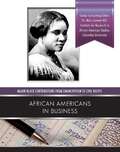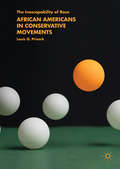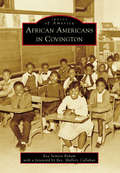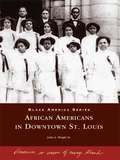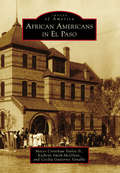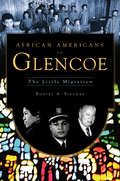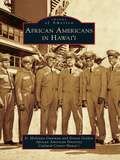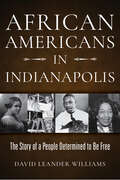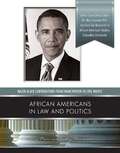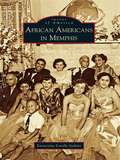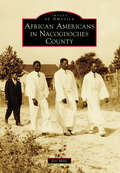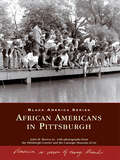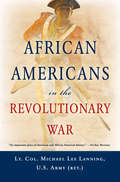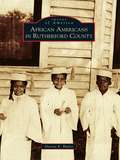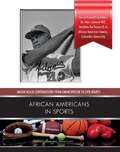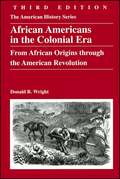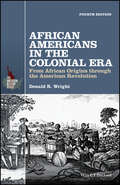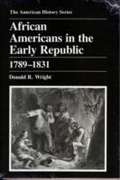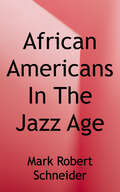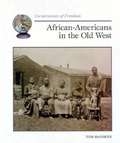- Table View
- List View
African Americans in Business (Major Black Contributions from Emancipat)
by Tish DavidsonMany people dream of owning their own business or making it to the top of the corporate ladder. In the pages of this book, you'll meet African Americans who overcame obstacles and stereotypes to make their dreams a reality. Madam C. J. Walker was orphaned at age 7, married at 14, became a mother at 18, and was widowed at 20. She went on make a million dollars selling hair care products. Berry Gordy loved music but went broke after opening a record store. He didn't give up, though. Gordy eventually started Motown Records, which became one of the country's most successful record labels and introduced a host of talented black artists to mainstream American audiences. Stanley O'Neal grew up on a farm without running water or indoor toilets. Through intelligence and hard work he became the head of a $50 billion investment bank. Read about these and other inspiring figures in this book.
African Americans in Conservative Movements: The Inescapability of Race
by Louis G. PrisockReveals the limitations of the “one-size fits all” perspective commonly used in conversations about African American conservatives.<P><P> Unwinds the complexities of black conservative relationships to the wider conservative movement and American society as large.<P> Explores what the Right and the African American conservative can do to avoid suspicions of “tokenism”.<P>Providing an expansive view of the making and meaning of African American conservatism, this volume examines the phenomenon in four spheres: the political realm, the academic world, the black church, and grass-roots activism movements. In his analysis of their activities in these realms, Louis Prisock examines the challenges African American conservatives face as they operate within the context of (largely white) conservatism. At the same time that African American conservatives challenge the white conservative movement’s principle of “color blindness,” they are accused of being “racial mascots,” or “tokens” from those outside of it. Prisock unwinds the intricacies of black conservatives’ relationships to both the wider conservative movement and the everyday life experiences of black Americans, showing that they are as vulnerable to the “inescability of race” as any other individual in a racialized America
African Americans in Covington (Images of America)
by Rev Mallery Callahan Eva Semien BahamCovington is the seat of St. Tammany Parish government and sits north of Lake Pontchartrain in the New Orleans metropolitan area. Records from 1727 show 11 Africans on the north shore. One person of African descent was present at the founding of Covington on July 4, 1813. Most African Americans in antebellum Covington were slaves, with a modest number of free people, all of whom covered nearly every occupation needed for the development and sustenance of a heavily forested region. For more than 200 years in Covington, African Americans transformed their second-class status by grounding themselves in shared religious and social values. They organized churches, schools, civic organizations, benevolent societies, athletic associations, and businesses to address their needs and to celebrate their joys.
African Americans in Downtown St. Louis (Black America Series)
by John A. Wright Sr.Since the founding of St. Louis in 1764, Downtown St. Louis has been a center of black cultural, economic, political, and legal achievements that have shaped not only the city of St. Louis, but the nation as well. From James Beckworth, one of the founders of Denver, Colorado, to Elizabeth Keckley, Mary Todd Lincoln's seamstress and author of the only behind-the-scenes account of Lincoln's White House years, black residents of Downtown St. Louis have made an indelible mark in American history. From the monumental Dred Scott case to entertainers such as Josephine Baker, Downtown St. Louis has been home to many unforgettable faces, places, and events that have shaped and strengthened the American experience for all.
African Americans in El Paso (Images of America)
by Kathryn Smith-Mcglynn Maceo Crenshaw Dailey Jr. Cecilia Gutierrez VenableEl Paso's African American community can trace its origins back to the 16th century, when the black Moor known as Esteban roamed the southwest and, more significantly, those Africans in the party of conquistador Juan de Oñate crossed the Rio Grande in 1598. The modern El Paso African American community began to take shape in the 1880s, as the railroad industry, military establishment, and agricultural community all had black Americans in their ranks. Black leaders and their followers established a school and founded several significant black churches. Texas's first state branch of the National Association for the Advancement of Colored People is recorded to have been formed in El Paso; the first major court cases that challenged the all-white Democratic primary came from this city; the Texas Western College basketball team won the NCAA championship in 1966 with five starting black players; and today, the city is inhabited by black military retirees, entrepreneurs, educators, and other professionals (each with vibrant and socially conscious organizations), making it a progressive model of community development.
African Americans in Glencoe: The Little Migration (American Heritage)
by Robert A. SidemanThe village of Glencoe has a proud history of early African American settlement. In recent years, however, this once thriving African American community has begunto disperse. Robert Sideman, a thirty-year Glencoe resident, relates this North Shore suburb's African American history through fond remembrances of Glencoe communitiessuch as the St. Paul AME Church, as well as recounting the lives of prominent African Americans. At the same time, Sideman poses a difficult question: how can the village maintainits diverse heritage throughout changing times? African Americans in Glencoe reveals an uplifting history while challenging residents to embrace a past in danger of being lost.
African Americans in Hawai'i (Images of America)
by D. Molentia Guttman African American Diversity Cultural Center Hawai'i Ernest GoldenDuring the early 1800s, about two dozen men of African descent lived in Hawai'i. The most noteworthy was Anthony D. Allen, a businessman who had traveled around the world before making Hawai'i his home and starting a family there in 1810. The 25th Black Infantry Regiment, also known as the Buffalo Soldiers, arrived in Honolulu at the Schofield Barracks in 1913. They built an 18-mile trail to the summit of Mauna Loa, the world's largest shield volcano, and constructed a cabin there for research scientists. After World War II, the black population of Hawai'i increased dramatically as military families moved permanently to the island. Hawai'i has a diverse population, and today about 35,000 residents, approximately three percent, claim African ancestry.
African Americans in Indianapolis: The Story of a People Determined to Be Free
by David L. WilliamsIndianapolis has long been steeped in important moments in African American history, from businesswoman Madame C. J. Walker's success to the rise of the Ku Klux Klan to the founding of Crispus Attucks High School, which remained segregated through the 1960s.In African Americans in Indianapolis, author and historian David Leander Williams explores this history by examining the daunting and horrendous historical events African Americans living in Indianapolis encountered between 1820 and 1970, as well as the community's determination to overcome these challenges. Revealing many events that have yet to be recorded in history books, textbooks, or literature, Williams chronicles the lives and careers of many influential individuals and the organizations that worked tirelessly to open doors of opportunity to the entire African American community. African Americans in Indianapolis serves as a reminder of the advancements that Black midwestern ancestors made toward freedom and equality, as well as the continual struggle against inequalities that must be overcome.
African Americans in Law and Politics (Major Black Contributions from Emancipat)
by Mary MainOn November 4, 2008, Americans went to the polls and elected the first black president in the history of the United States. Barack Obama was clearly a gifted politician with impressive achievements and a compelling life story. Still, his historic election wouldn't have been possible if earlier generations of African Americans hadn't paved the way. This book tells the stories of pioneering African-American lawyers and politicians. It details their efforts to guarantee black people the same rights enjoyed by other Americans, including the right to vote. In courtrooms, statehouses, and the halls of Congress, the people profiled in this book have helped make the United States what the framers of the Constitution hoped: "a more perfect Union."
African Americans in Memphis (Images of America)
by Earnestine Lovelle JenkinsMemphis has been an important city for African Americans in the South since the Civil War. They migrated from within Tennessee and from surrounding states to the urban crossroads in large numbers after emancipation, seeking freedom from the oppressive race relations of the rural South. Images of America: African Americans in Memphis chronicles this regional experience from the 19th century to the 1950s. Historic black Memphians were railroad men, bricklayers, chauffeurs, dressmakers, headwaiters, and beauticians, as well as businessmen, teachers, principals, barbers, preachers, musicians, nurses, doctors, Republican leaders, and Pullman car porters. During the Jim Crow era, they established social, political, economic, and educational institutions that sustained their communities in one of the most rigidly segregated cities in America. The dynamic growth and change of the post-World War II South set the stage for a new, authentic, black urban culture defined by Memphis gospel, blues, and rhythm and blues music; black radio; black newspapers; and religious pageants.
African Americans in Nacogdoches County (Images of America)
by Jeri MillsTypical of most communities after the Civil War, Nacogdoches's African Americans had to repurpose their lives by building their own communities while they carved a life of survival first and progress second. The images in this book will tell the stories of the first churches and how they became the center of the community. Other images will share information about the early leaders in the community who helped establish educational facilities for "Negroes." Additional images focus on black businesses, and a final set of images will discuss the emerging black middle class and others who played significant roles in Nacogdoches history. Readers of this book will go on a journey, through images, that highlights residents' pains of struggles and gains of triumph.
African Americans in Pittsburgh (Black America Series)
by Carnegie Museum of Art Pittsburgh Courier John M. Brewer Jr.African Americans in Pittsburgh chronicles the distinct trends in this African American community. There was never one centralized neighborhood where a majority of the black population lived, and city schools were integrated until after desegregation laws were passed. Photographs captured by famed Pittsburgh photographer Charles "Teenie" Harris show the candid experiences of residents, including the achievements and celebrations of people struggling to put scraps of food on the table.
African Americans in Radio, Film, and TV Entertainers (Major Black Contributions from Emancipat)
by Linda J. ArmstrongThis book is filled with fascinating stories, from the night a shy young woman's play changed Broadway to the day the most successful talk show host in history got her start. Find out about the stage actor who once earned letters in four college sports--and who won academic honors, too. Follow the triumphs and disappointments of some of the most famous black entertainers in our nation's history. Rediscover great personalities who have been forgotten. And learn about how the roles of black performers both changed with and helped changed American society.
African Americans In The Revolutionary War
by Lt. Col. Lanning&“A thorough, long-overdue study of Black Americans&’ contributions during the War of Independence. . . . An important piece of American and African American history.&”—Kirkus Reviews In this enlightening and informative work, military historian Lt. Col. Michael Lee Lanning (ret.) reveals the little-known, critical, and heroic role African Americans played in the American Revolution, serving in integrated units—a situation that would not exist again until the Korean War—more than 150 years later . . . At first, neither George Washington nor the Continental Congress approved of enlisting African Americans in the new army. Nevertheless, Black men—both slave and free—filled the ranks and served in all of the early battles. Black sailors also saw action in every major naval battle of the Revolution, including members of John Paul Jones&’s crew aboard the Bonhomme Richard. At least thirteen Black Americans served in the newly formed U.S. Marine Corps during the war. Bravery among African Americans was commonplace, as recognized by their commanders and state governments, and their bravery is recorded here in the stories of citizen Crispus Attucks at the Boston Massacre; militiaman Price Esterbrook at Lexington Green; soldier Salem Poor at Bunker Hill; and marine John Martin aboard the brig Reprisal. As interest in colonial history enjoys renewed popularity due to works like Hamilton, and the issues of prejudice and discrimination remain at the forefront of our times, African Americans in the Revolutionary War offers an invaluable perspective on a crucial topic that touches the lives of Americans of every color and background.
African Americans in Rutherford County (Images of America)
by Devora E. ButlerAfrican Americans have heavily contributed to and shaped the unique and vibrant Rutherford County in middle Tennessee. Located 30 miles southeast of Nashville, Rutherford County is at the state's geographical center. This area is home to the Stones River National Battlefield, a national park that was the site of a major Civil War battle--the Battle of Stones River. Tourists come from all over the world to experience this rich cultural and historic venue that once served, although briefly, as the capital of Tennessee. African American men and women have lived, worked, and toiled here for generations.
African Americans in Sports (Major Black Contributions from Emancipat)
by James NasiumThis book profiles some of the greatest African-American athletes of the past 150 years. They competed in sports ranging from boxing and horse racing to track and field, basketball, and baseball. As you'll discover, what these champions accomplished on the field of competition was often but a small part of their story. Read, for example, about how doctors thought Wilma Rudolph might never walk after a childhood bout of polio--but she went on to sprint her way to three Olympic gold medals. Or how the fiery Jackie Robinson silently endured a torrent of abuse in order to break baseball's "color barrier." Find out the connection between a stolen bike and Muhammad Ali's legendary boxing career. And learn how the African-American sports heroes of the past helped pave the way for superstars of the present, such as Kobe Bryant, Tiger Woods, and Candace Parker.
African Americans in Sports
by Gary A. SailesResearch on African American athletes generally fo-cuses on negative stereotypes of physical prowess, and socially controversial themes. Most studies in-vestigate racism, prejudice, discrimination, and ex-ploitation experienced by African American athletes. Many studies contrast African American and white athletes on a number of variables that support pre-vailing elitist stereotypes and denigrate African Ameri-can athletes. But few studies investigate the diverse and complex cultural dichotomies within the infrastruc-ture of sport in the African American community. Gary Sailes maintains that it is crucial to develop a more eclectic and immersed cultural approach when investigating African American involvement in com-petitive sports. The contributors to 'African Americans in Sports' show that there are also intrinsic cultural paradigms that are evident, presenting an informa-tive and interesting narrative regarding African American athletes. The chapters that make up this volume were written by noted scholars who were selected based on their expertise in their specific academic areas. They write about different components of the experience of African American male athletes. Chapters and contributors include: "Race and Athletic Performance: A Physiological Review" by David W. Hunter; "The Athletic Dominance of African Americans--Is There a Genetic Basis?" by Vinay Harpalani; "African American Player Codes on Celebration, Taunting, and Sportsmanlike Conduct" by Vernon L. Andrews; and "Stacking in Major League Baseball" by Earl Smith and C. Keith Harrison. Many chapters were originally published as a special issue of the 'Journal of African American Men.' This volume should be read by all those involved in athletics, as well as by sports sociologists and African American studies scholars.
African Americans in Sports: African Americans In Sports
by David K. WigginsThis two-volume set features 400 articles on African-Americans in sports, including biographical entries as well as entries on events, tournaments, leagues, clubs, films, and associations. The entries cover all professional, amateur, and college sports such as baseball, tennis, and golf.
African Americans in the Colonial Era: From African Origins through the American Revolution
by Donald R. WrightOver recent decades few topics of American history have been subject to greater attention and more thorough revision than African Americans in colonial times. Acclaimed works by leading scholars, relying on new bodies of evidence and writing from a fresh, Atlantic perspective, have provided a broadened, more nuanced view of the topic. In this third edition of one of the most popular books in our American History Series, Donald Wright works new interpretations into a narrative that provides a clear understanding of the scope and nature of the early African-American experience. Included are discussions of African Americans African origins; the Atlantic slave trade, based on the latest data from an on-line Trans-Atlantic Slave Trade Database; the origins of slavery and race-based prejudice in the mainland colonies; the evolutionary formation of African-American culture; and the effects of the American Revolution on men and women of African descent, at the time and long thereafter. This third edition views African Americans in the British North-American mainland colonies more as their contemporaries did: as persons from one of the four continents who interacted economically, socially, and politically over a period of 180 years in a vast, vibrant, complex Atlantic world. It shows how the mainland North-American society that resulted from these interactions reflected the mix of Atlantic cultures and how the republic that a group of these people eventually constructed used European ideas to support creation of a favorable situation for those in control, persons largely of European descent. The African and African-American men and women, whose forebears had added greatly to the region s economic and cultural viability, found themselves in 1789 with the least benefit from the nation they helped bring into existence. Of special value is the book s bibliographical essay, an expansion and updating of earlier versions that led the historian Ira Berlin to label Wright the historiographer of slavery in the early period.
African Americans in the Colonial Era: From African Origins through the American Revolution (The American History Series #32)
by Donald R. WrightWhat are the origins of slavery and race-based prejudice in the mainland American colonies? How did the Atlantic slave trade operate to supply African labor to colonial America? How did African-American culture form and evolve? How did the American Revolution affect men and women of African descent? Previous editions of this work depicted African-Americans in the American mainland colonies as their contemporaries saw them: as persons from one of the four continents who interacted economically, socially, and politically in a vast, complex Atlantic world. It showed how the society that resulted in colonial America reflected the mix of Atlantic cultures and that a group of these people eventually used European ideas to support creation of a favorable situation for those largely of European descent, omitting Africans, who constituted their primary labor force. In this fourth edition of African Americans in the Colonial Era: From African Origins through the American Revolution, acclaimed scholar Donald R. Wright offers new interpretations to provide a clear understanding of the Atlantic slave trade and the nature of the early African-American experience. This revised edition incorporates the latest data, a fresh Atlantic perspective, and an updated bibliographical essay to thoroughly explore African-Americans’ African origins, their experience crossing the Atlantic, and their existence in colonial America in a broadened, more nuanced way.
African-Americans in the Early Republic, 1789-1831
by Donald R. Wright"This is a study of African Americans in the early republic, which, as it is defined here, is the time beginning with Washington's inauguration in 1789 and ending with Nat Turner's rebellion in 1831." Other books in the American History Series are available from Bookshare.
African Americans in the Jazz Age: A Decade of Struggle and Promise
by Mark Robert SchneiderThe victorious end to the first World War offered hope to African Americans who had fought for freedom abroad and hoped to find it at home. In this new work, historian Mark R. Schneider analyzes the dynamic 1920s that saw the enormous migration of African Americans to Northern urban centers and the formation of important <p><p>African American religious, social and economic institutions. Yet, even with considerable efforts to promote civil rights and advancements in the arts, many African Americans in the rural south continued to live under conditions unchanged from a century before. African Americans in the Jazz Age recounts the history of this turbulent era, paying particular attention to the ways in which African Americans actively challenged Jim Crow and firmly expressed pride in their heritage. <p><p>Supplemented by primary sources, this work serves as an ideal introduction to this critical period in U.S. history and allows students to examine the issues first-hand and draw their own conclusions.
African Americans in the Military (Major Black Contributions from Emancipat)
by Marcia Amidon LustedAfrican Americans have participated in all of the country's major conflicts, from the Revolutionary War to the present. Their contributions were vital and their courage on the battlefield commendable. Often, however, the nation was less than grateful. This book tells the story of blacks in the U.S. military. It is a story of courage and honor--a story that will both fascinate and inspire.
African-Americans in the Old West (Cornerstones of Freedom)
by Tom McgowenDescribes the important role of freed slaves and other African-Americans in the settlement of the Western US.
